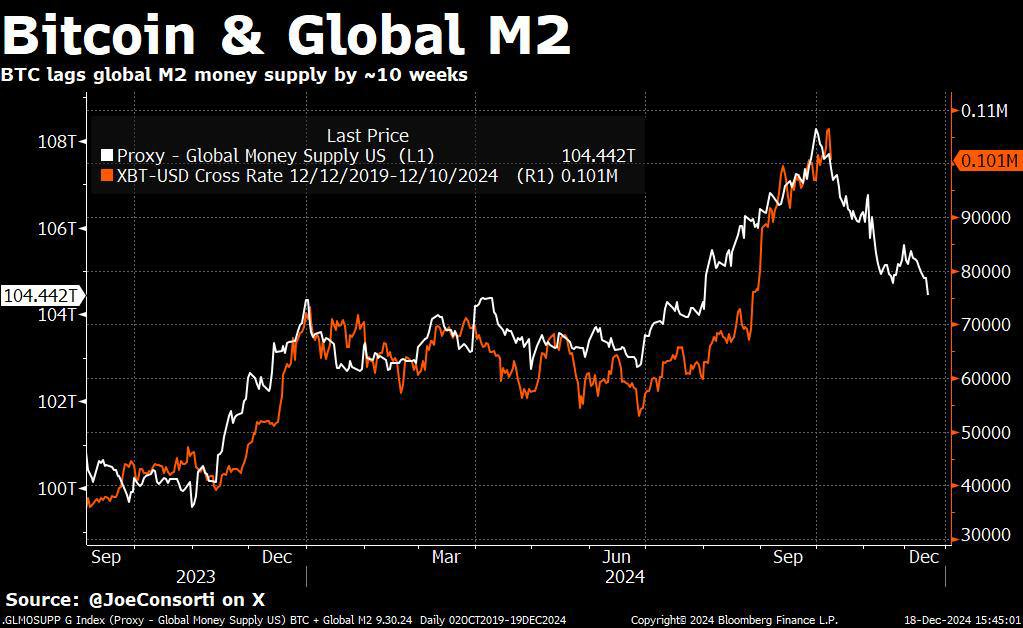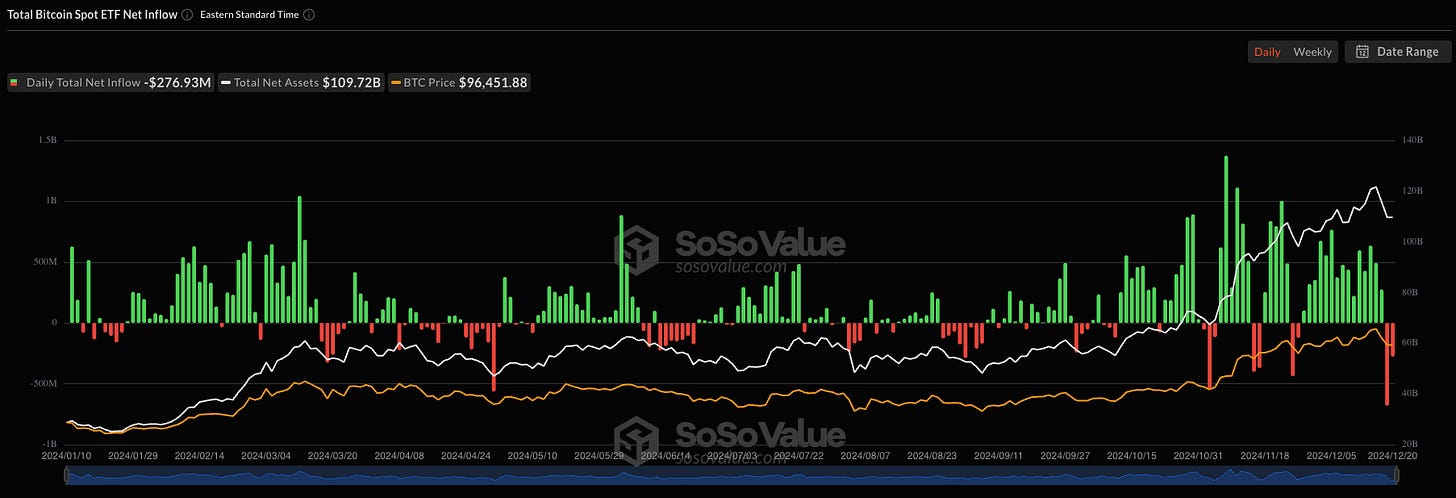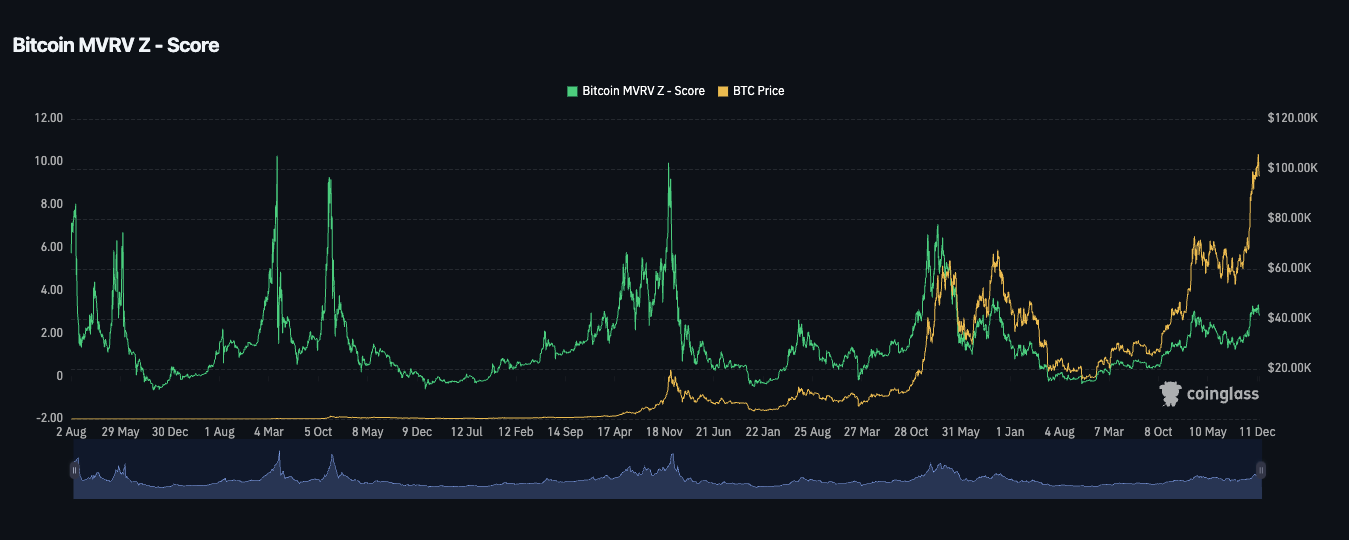The crypto market has entered a new phase as Bitcoin navigates its first significant correction since breaking the psychological $100,000 barrier, pulling back to $95,000 from its peak of $108,315. This price action comes at a pivotal moment, marked by fundamental shifts in market structure, unprecedented institutional adoption, and evolving correlations with traditional macro factors.
The correction arrives amid a complex backdrop: spot ETFs have emerged as the largest Bitcoin holders, traditional institutional participation is expanding beyond Bitcoin to Ethereum, and historical correlations with global liquidity are showing signs of decoupling. These developments suggest we're witnessing not just a price milestone, but a transformation in how Bitcoin trades and what drives its value.
The Journey to $100k and Beyond
Bitcoin's recent breakthrough of the $100,000 level came in two distinct waves. The first attempt was primarily driven by leverage, with open interest and funding rates reaching unsustainable levels.
This resulted in a sharp pullback as approximately $5 billion in leveraged positions were liquidated. However, the second breakthrough was built on firmer ground, supported by spot buying rather than leverage, with open interest $1.5 billion lower and funding rates returning to historical norms of 0.01%. As we enter the final stretch of 2024, market dynamics are likely to be influenced by typical holiday season patterns – notably thinner liquidity, heightened volatility, and potential directional uncertainty as traders reduce risk exposure and close out their yearly positions. This period often sees decreased institutional participation and more erratic price action, making it crucial for traders to manage position sizes and risk carefully.
Institutional Adoption Reaches New Heights
Perhaps the most significant development in the Bitcoin ecosystem is the unprecedented institutional adoption through spot ETFs.
In just six weeks, these vehicles have accumulated a net 130,000 BTC, with their assets under management increasing by 79.1% ($53.35 billion) – outperforming all other U.S. ETF products during this period. More remarkably, U.S. spot Bitcoin ETFs have now surpassed Satoshi Nakamoto as the largest Bitcoin holder, with 1,135,000 BTC under management.
This institutional appetite extends beyond Bitcoin, as evidenced by the remarkable growth in Ethereum ETF assets under management, which have surged from $6 billion to $14 billion.
This parallel growth suggests a broadening institutional interest in digital assets, with expectations of intensified institutional FOMO around ETH ETF products heading into Q1 2025. The strong end-of-year institutional inflows across both Bitcoin and Ethereum ETFs signal a potential shift in traditional finance's approach to digital assets, likely setting the stage for continued institutional adoption in the coming quarters.
Market Maturity Indicators
The MVRV Z-Score, currently at 2.89x, suggests we're far from the overheated conditions that typically signal market tops.
The MVRV-Z score is a relative indicator, which is the "circulating market value" of Bitcoin minus the "realised market value", and then standardised by the standard of the circulating market value. The formula is:
Historical peaks occurred at:
11.7x in 2017
7.5x in 2021 (35% lower than previous cycle)
Following this cyclical pattern of diminishing peaks (approximately 35% reduction per cycle), we can project this cycle's potential peak MVRV-Z score at around 4.88x. This would suggest a theoretical price target of approximately $160,000 for this cycle - notably lower than the $240,000 target we'd get if we assumed this cycle would reach 2021's peak of 7.5x, signalling significant upside.
Global Liquidity and Monetary Dynamics
Bitcoin's relationship with global liquidity continues to be one of its most reliable correlations, with price movements tracking liquidity conditions 83% of the time over 12-month periods. This relationship has become increasingly important as Bitcoin matures into a macro asset.
What appears to be a decline in global liquidity is actually a change in USD valuation due to the recent dollar rally, rather than an actual contraction in monetary conditions. In national currencies, liquidity continues to rise, particularly evident in the flow to savings accounts and money market funds in the US.

From September 2023 to December 2024, key trends in the Global Liquidity Index show:
Global Liquidity maintaining a consistent upward trajectory before recent decline
Bitcoin's price movements following this trajectory with a lag
Sharp acceleration in both metrics during Q3-Q4 2024, with Liqudity now showing weakness
This relationship takes on additional significance given the current macro environment:
The Fed has signalled further rate cuts in 2025
Global central banks are moving towards easier monetary conditions
Fiscal deficits continue to expand across major economies
More stimulus is expected following Trump's inauguration
However, two important shifts are occurring in this historical relationship. First, since the introduction of spot ETFs in early 2024, we've seen signs of de-correlation between Bitcoin and M2. Second, if markets begin pricing in a potential U.S. Strategic Bitcoin Reserve under the new administration, Bitcoin could maintain upward momentum regardless of M2 trends. These changes suggest Bitcoin is evolving beyond its traditional monetary correlations toward a more mature asset class driven by institutional and sovereign adoption.
Altcoin Market Dynamics
The altcoin market has shown interesting patterns relative to Bitcoin's performance, particularly in the recent rally and subsequent correction. The top 100 vs BTC (90-day performance) reached 80%, matching levels seen in January 2024, before a notable divergence began to emerge reaching current levels of 46%.
Looking at different market cap segments, early December saw uniform strength:
Top 20-50: Reached peak performance of ~90% relative to BTC
Top 50-100: Similarly peaked around 80-85%
Top 100-200: Showed comparable strength
While initial momentum lifted all segments equally - a classic "rising tide lifts all boats" scenario characteristic of mid-cycle alt rallies - the subsequent correction has revealed a more nuanced market. The broad retracement to 20-50% of relative performance against BTC hasn't been uniform.
Assets with strong fundamentals in each market cap tier continue to outperform BTC, suggesting a maturing market that increasingly discriminates based on project fundamentals rather than mere category association.
This evolving pattern is significant for several reasons:
The initial uniform strength demonstrated broad market participation and liquidity
The sharp reversal highlighted Bitcoin's role as a safe haven during uncertainty
The selective outperformance during correction indicates a more sophisticated market
Deep fundamentals, rather than mere market category, are driving sustained performance
A New Era Unfolds
As we move into 2025, we anticipate a strong year for the broader crypto market, supported by three major tailwinds:
Macro environment: Expected rate cuts and expanding global liquidity conditions
Regulatory clarity: Growing clarity from US regulation
Market maturity: Increasing sophistication in valuing digital assets
The current market environment presents an attractive window for strategic deployment and active management. We expect outperformance from assets that demonstrate strong fundamentals, particularly those with mechanisms to capture and distribute value to token holders. The market's recent behaviour during the correction - where quality assets maintained strength despite broader market pressure - validates this trend.
While the altcoin market has historically moved in lockstep with Bitcoin during major moves, we're seeing increasing differentiation based on fundamental value drivers. Projects that can demonstrate real utility, revenue generation, and value accrual mechanisms are likely to outperform in this more discriminating market environment.
Near-term challenges remain, particularly around holiday liquidity conditions. Yet these short-term fluctuations appear secondary to the larger structural shifts underway - the evolution of crypto into a mature asset class with deepening institutional integration while maintaining its innovative potential in reshaping financial services.
From all of us at Team Archimed, we wish you a Happy Holidays, Merry Christmas and a Happy New Year. Thank you for your continued support throughout 2024, and we look forward to sharing more insights and opportunities with you in what promises to be an exciting 2025.












